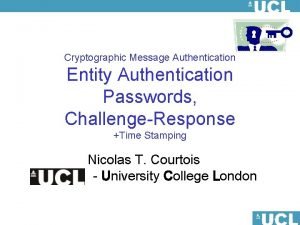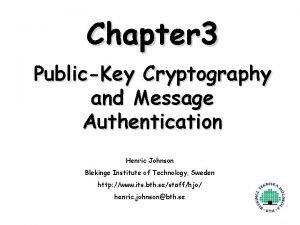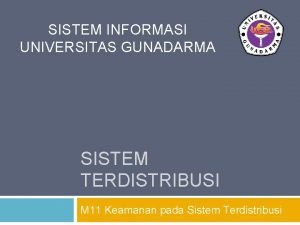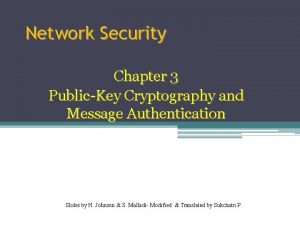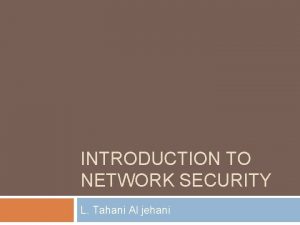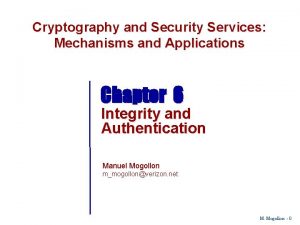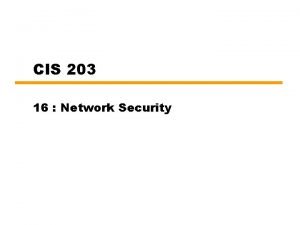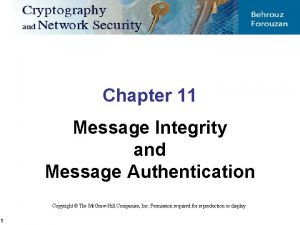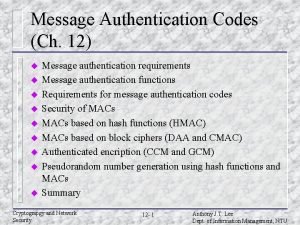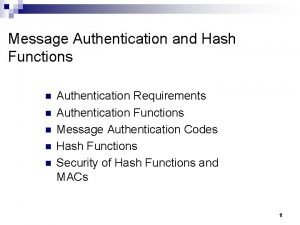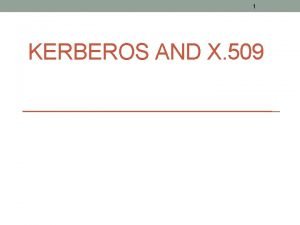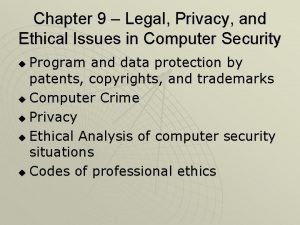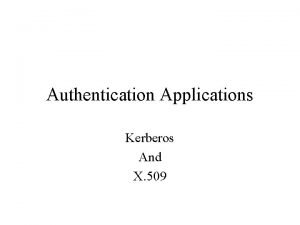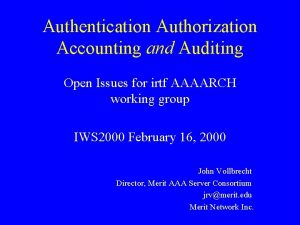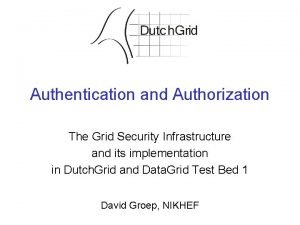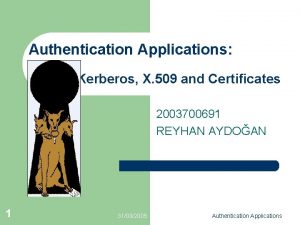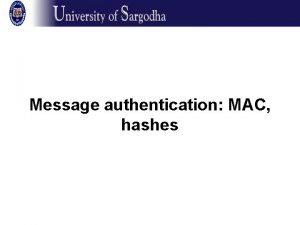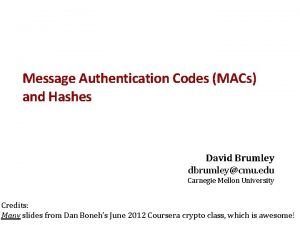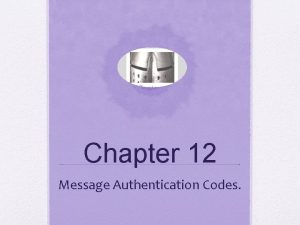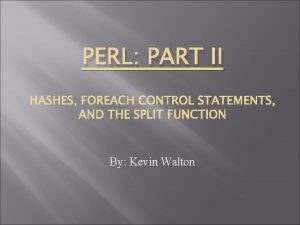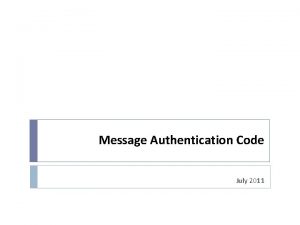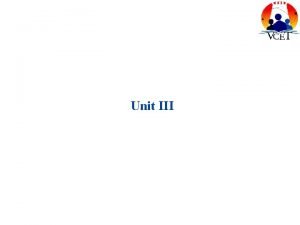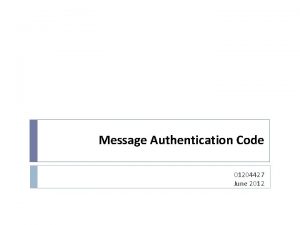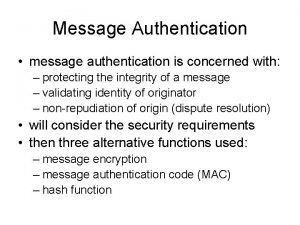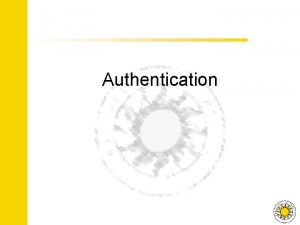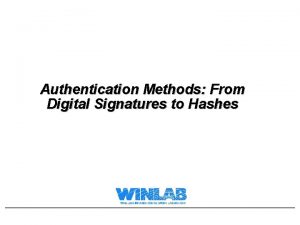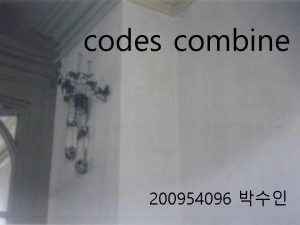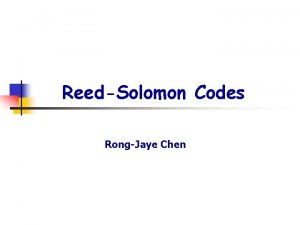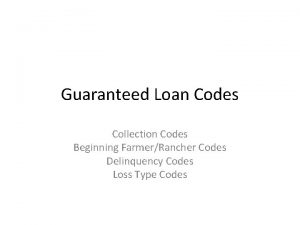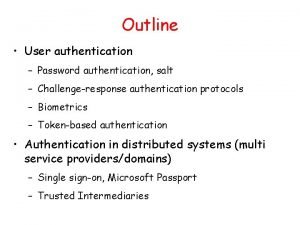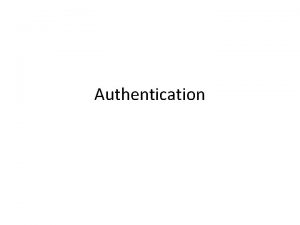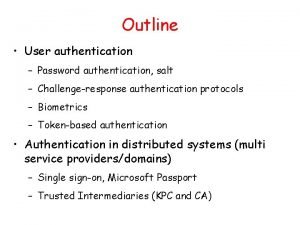Computer Security Message Authentication Codes Hashes and Message



























- Slides: 27

Computer Security Message Authentication Codes, Hashes and Message Digests 31 December 2021 © 2004, Bryan J. Higgs 1

What Problems are We Trying to Solve? • Authentication – The process of reliably verifying the identity of someone or something • In particular, did a message indeed come from its specified sender? • Need to guard against: – Disclosure of a message to any unauthorized person or system – Messages masquerading as being from a source – Content modification • Was the message changed between sender and recipient? ) – Source or destination repudiation • Can the sender or recipient deny they sent/received the message? 2

Authentication Functions • Three main classes: – Message Encryption • Ciphertext of entire message serves as its authenticator – Message Authentication Code (MAC) • Function of the message and a secret key which produces a fixed-length authenticator value – Hash Function • Function which maps a message of any length into a fixed-size hash authenticator value 3

Message Encryption • We've already seen various encryption options: – Symmetric Encryption – provides both confidentiality and authentication – Public Key Encryption: Ø provides confidentiality only Ø provides authentication & signature Ø provides confidentiality, authentication, and signature 4

Message Authentication Code (MAC) • Uses a secret key to generate a small fixed-size block of data: a Cryptographic Checksum, or MAC • If Alice and Bob share a common secret key, K, then: MAC = FK(P) where: P is the input plaintext F is the MAC function K is the shared secret key MAC is the resulting message authentication code 5

Message Authentication Code (MAC) • The MAC is sent to the recipient along with its associated message – The recipient uses the same MAC function and key on the message and compares the result with the transmitted MAC. – If the two MACs match, the recipient is assured that: • The message has not been altered, and • The message is from the alleged sender – If the message contains a sequence number (e. g. TCP header), then the recipient is assured of the proper sequencing of messages 6

Message Authentication Code (MAC) • A MAC function is similar to an encryption function, except that the MAC function need not be reversible. • A MAC function is typically a many-to-one function: – The input messages can be of any length, but – The output is of fixed length (n bits) • If an n-bit MAC function (that is, a MAC function that generates a fixed-size n-bit block) is used, how many possible MAC values are there? n 2 7

Message Authentication Code (MAC) • For example, assume: – We are using a 10 -bit MAC function – We are using 100 -bit messages • There are: – 2100 (~ 1. 27 * 1030) different possible messages: – only 210 (1024) different possible MACs so, on average, each MAC value is generated by a total of different messages 8

Message Authentication Code (MAC) • Here are some basic uses of MACs: M = P || FK(P) • Plaintext concatenated with MAC • Provides authentication only P = Plaintext C = Ciphertext E = Encryption function F = MAC function K = Key M = Message sent • Symmetric key encrypted ciphertext concatenated with plaintext MAC • Provides authentication and confidentiality • Authentication tied to plaintext • Symmetric key encrypted ciphertext concatenated with ciphertext MAC • Provides authentication and confidentiality • Authentication tied to ciphertext 9

Message Authentication Code (MAC) • Why use MACs for authentication, instead of symmetric encryption? – Performance – MAC functions are faster than encryption functions – Some applications don't care about secrecy/confidentiality, but care a lot about authentication (e. g. SNMP) – Separation of authentication and confidentiality provides greater flexibility. – Certain applications may wish to prolong the period of authentication so that a message can undergo several phases of processing which rely on that authentication. • As soon as the message is decrypted, the message is no longer protected against modification • A MAC can be kept with the message to retain this protection. 10

Message Authentication Code (MAC) • One of the most widely used MACs is the Data Authentication Algorithm (DAA), based on on DES – DAA is both a FIPS publication (FIPS PUB 113*) and an ANSI standard (X 9. 17) – It uses the Cipher Block Chaining (CBC) mode of operation with an initialization vector of zero. – The data are grouped into contiguous 64 -bit blocks; if necessary, the final block is padded on the right with zeroes to form a full 64 -bit block. – Using the DES encryption algorithm, E, and a secret key, K, a Data Authentication Code (DAC) is calculated. . . *http: //www. itl. nist. gov/fipspubs/fip 113. htm 11

Digital Authentication Algorithm 12

One-Way Hash Functions • Can be viewed as a variation on a MAC function: – A Hash Function accepts a variable-size message, M, as input and produces a fixed-size output, referred to as a Hash Code, or Message Digest: h = H(M) – Unlike a MAC function, a hash code: • does not use a key, and so • is a function only of the input message – A change to any bit (or bits) of the message results in a change to the hash code, which can provide an error-detection capability. – A message digest can be used as a fingerprint for a message, to allow detection of message modification 13

One-Way Hash Functions • Requirements for a hash function are: – Can be applied to a block of data of any size – Produces a fixed-length output – H(M) is relatively easy to compute for any given M, allowing for both software and hardware implementations – For any given value h, it is computationally infeasible to find M such that h = H(M). This is the One-way Property. – For any given block, M, it is computationally infeasible to find M' != M with H(M') = H(M). • This is called Weak Collision Resistance. – It is computationally infeasible to find any pair (M, M') such that H(M) = H(M'). • This is called Strong Collision Resistance. 14

One-Way Hash Functions • Here are some basic uses of hash functions: – Provides confidentiality and authentication – Provides authentication (amounts to a MAC) – Provides authentication – Also provides a digital signature (because only the sender could have produced the encrypted hash code) 15

One-Way Hash Functions • . . . and some more: – Provides confidentiality, authentication and digital signature – Provides authentication, using a shared secret, S – Adds confidentiality to the above mechanism. 16

One-Way Hash Functions • The drive for hash/message digest algorithms began with public key cryptography – RSA was invented, but it was slow enough at that time to make it impractical when used alone. – A cryptographically secure message digest algorithm with high performance would make RSA much more useful. 17

One-Way Hash Functions • Thus, MD (unpublished) and MD 2 (defined in RFC 13191) were invented by Ron Rivest (of RSA fame) – MD 2 is a 128 -bit one-way hash function • Ralph Merkle (of Xerox at the time, but who had worked at Stanford with Diffie & Hellman) came up with a message digest algorithm called SNEFRU 2 – It was several times faster than MD 2 – It is a 128 -bit or 256 -bit one-way hash function • This prompted Rivest to respond with MD 4 (defined in RFC 13203) – MD 4 produces a 128 -bit hash 1 http: //www. faqs. org/rfcs/rfc 1319. html 2 Snefru was an Egyptian Pharaoh 3 http: //www. faqs. org/rfcs/rfc 1320. html 18

One-Way Hash Functions • Weaknesses were found in the MD 4 algorithm, so Rivest came up with MD 5 (defined in RFC 13211) – MD 5 is similar to MD 4, but improved. – More complex than MD 4, but similar in design – Also produces a 128 -bit hash 1 http: //www. faqs. org/rfcs/rfc 1321. html 19

One-Way Hash Functions • The NSA designed the Secure Hash Algorithm (SHA) • The National Institute of Standards and Technology (NIST), made it a standard. – They revised it very late in the game, because of some (unspecified) weakness that had been found, and changed its name to SHA-11. – SHA-1 is a 160 -bit hash function based on MD 4 – Shares much in common with MD 5, but has a much more conservative design. – 2 or 3 times slower than MD 5 1 http: //www. itl. nist. gov/fipspubs/fip 180 -1. htm 20

One-Way Hash Functions • Because of improving computing environments, the 160 -bit hash of SHA-1 is now becoming a liability • So NIST produced SHA-256, SHA-384, and SHA-5121. – Designed to be used with the 128 -, 192 - and 256 -bit key sizes of AES. – Structure similar to SHA-1, but much slower. – According to Ferguson & Schneier, they are too new to have experienced significant cryptanalysis attacks, and so are not yet proven. But they also say that MD 5 and SHA-1 are not sufficiently secure, so you may have little choice. 1 http: //csrc. nist. gov/publications/fips 180 -2/fips 180 -2. pdf 21

Typical Usage of Digests • Here's an example of the use of SHA-1 in a real application – Java JAR files: – In the jce. jar (Java Cryptography Extension) JAR file, the manifest contains the following: Manifest-Version: 1. 0 Created-By: 1. 4. 1 -internal (Sun Microsystems Inc. ) Name: javax/crypto/Sealed. Object. class SHA 1 -Digest: R+GWl 6 Zuqgtty 1 z. Oa. P 5 Rr. RSGf. Qo= Name: javax/crypto/Key. Agreement. Spi. class SHA 1 -Digest: fdmlqpi. TKMz. V 65+93 O 4 t. J 3 Uo 6 wg= Name: javax/crypto/spec/DESede. Key. Spec. class SHA 1 -Digest: Q 7 UJv. Luk 8 GST 42 GW 6 x. Dl. XHe 3 Xv 8= Name: javax/crypto/spec/DHParameter. Spec. class SHA 1 -Digest: y 0 o. Y 9 yd/BQQx. Ec/2 q 1 Cytta/r 2 E= Name: javax/crypto/interfaces/DHPrivate. Key. class SHA 1 -Digest: jwgw 7 pak. Ty. KOl. LBNivsp 6 V 6 Ad 4 k=. . . 22

One-Way Hash Functions • Ferguson & Schneier 1 recommend the following: – They don't feel that any of the existing hash functions is sufficiently secure when used as is. – So, they define a double hash function, hd = h(h(m)) – They recommend the use of SHAd-256, or, for higher security levels, SHAd-512 1 Practical Cryptography, by Niels Ferguson and Bruce Schneier, Wiley. 23

HMAC • HMAC 1 is an attempt to use a hash function to build a MAC. • Note that: – Hash functions provide only n/2 bits of security against some attacks – A MAC function is expected to provide n bits of security. – Defining: MAC(K, m) = h(K || m), or h(m || K), or h(K || m || K) is not secure if you use one of the standard hash functions. • HMAC was proven to be secure if the underlying hash function's underlying compression function was secure. 1 http: //www. faqs. org/rfcs/rfc 2104. html There is also a draft FIPS at: http: //csrc. nist. gov/Crypto. Toolkit/hmac/fr-hmac-200101. html 24

HMAC • HMAC takes a variable length key and a variable length message, and produces a fixedsize output that is the same size as the underlying hash function. – It first pads the key with 0 bits to 512 bits – If the key is larger than 512 bits, it first hashes the key, resulting in 128 or 160 bits, and then pads the result out to 512 bits. – It then XORs the padded key with a constant string of octets of value 36 (hex), then concatenates the result with the message, and computes a hash (digest) – It XORs the padded key with a different constant string of octets of value 5 C (hex), concatenates that with the result of the first hash, and computes a second hash on that. 25

HMAC • Examples of HMAC algorithms are: – Hmac. MD 5 – uses the MD 5 hash algorithm – Hmac. SHA 1 – uses the SHA-1 hash algorithm 26

Summary • We've covered: – A little about authentication – Somewhat more about Message Authentication Codes (MACs) – Even more about One-Way Hash Functions (also known as Message Digests or Message Digest Functions) • We have also seen how they are all related to previous cryptography topics 27
 Iff
Iff What is peer entity authentication
What is peer entity authentication Cipher-based message authentication code
Cipher-based message authentication code Public key cryptography and message authentication
Public key cryptography and message authentication Authentication in cryptography and network security
Authentication in cryptography and network security Private secruity
Private secruity Sistem terdistribusi gunadarma
Sistem terdistribusi gunadarma Message authentication code
Message authentication code Approaches to message authentication
Approaches to message authentication Message authentication is a service beyond
Message authentication is a service beyond Message authentication code
Message authentication code Ecb electronic signature
Ecb electronic signature Message authentication code
Message authentication code Message authentication code
Message authentication code Message integrity in cryptography
Message integrity in cryptography Message authentication functions
Message authentication functions Message authentication requirements
Message authentication requirements System.security.authentication
System.security.authentication Security radio codes
Security radio codes Wireless security in cryptography and network security
Wireless security in cryptography and network security Electronic commerce security
Electronic commerce security Kerberos
Kerberos Difference between law and ethic
Difference between law and ethic Kerberos x.509
Kerberos x.509 Authentication filters in mvc 5
Authentication filters in mvc 5 Authentication authorization auditing
Authentication authorization auditing Grid security infrastructure
Grid security infrastructure Kerberos x.509
Kerberos x.509
